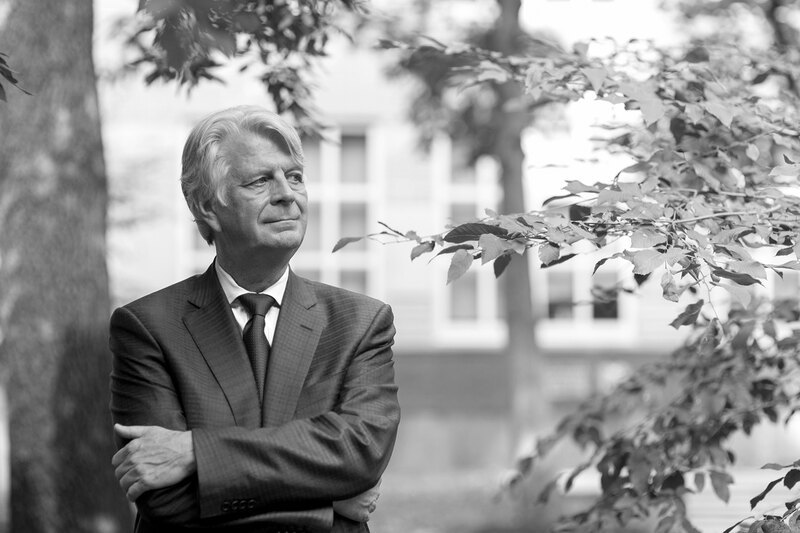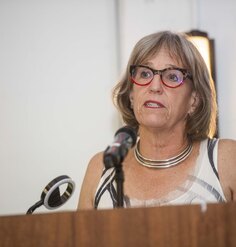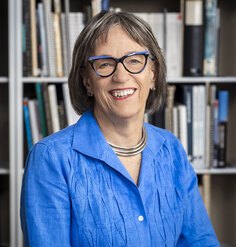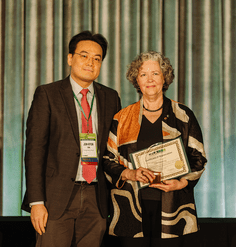A Conversation with Fritz Steiner, LAF Medal Winner

Frederick “Fritz” Steiner, FASLA, FAAR, RAAR, SITES AP is the 2024 recipient of the LAF Medal, which recognizes individuals who have made a significant and sustained contribution to the LAF mission of supporting the preservation, improvement, and enhancement of the environment. Ahead of the LAF Symposium and Awards Dinner, we chatted with Fritz about his career, how the field has changed, and why he's hopeful that landscape architects can tackle the big issues of our day.
A typical work day for Fritz Steiner starts on his front porch, where he catches up on emails and the progress a pair of robins is making on their nest in his cherry laurel tree. He often points out the birds to the river of kids walking past with their parents—many of them his colleagues—on their way to the nearby elementary school. After this moment with nature and neighbors, he walks eleven blocks to the University of Pennsylvania campus for all the meetings, teaching, budget documents, and decisions that come with leading the Stuart Weitzman School of Design.
Walking onto campus, he passes through landscapes and spaces he’s helped to shape. Inadvertently, Fritz has become somewhat of a campus planner, becoming deeply involved in campus design at the universities where he has worked (Arizona State University, The University of Texas at Austin, and now Penn). At UT Austin, he chaired the Campus Planning Committee. At Penn, he co-chairs the similarly tasked Design Review Committee, which means he’s involved in every building, every landscape, and every placement of public art. When asked about his long career and the projects that bring him the most pride, he lists these space. “I look out my window to the Stuart Weitzman Plaza, designed by Laurie Olin and his colleagues, and realize I made that happen, and then I look at College Green—that’s Peter Shepheard, Carol Franklin, Linda Jewell, Bob Hanna, and Laurie Olin again—all my teachers shaped that place. It’s something I experience every day.”
Penn, of course, is where Fritz studied under renowned landscape architect and planner Ian McHarg. As a student at the University of Cincinnati, Fritz read McHarg’s Design with Nature and decided that was his path too. A few years after completing a Master of Community Planning at Cincinnati, he started pursuing a Master of Regional Planning at Penn, where McHarg had founded the school’s landscape architecture program and continued to teach at that time. When he wasn’t in the studio, Fritz paid his way through school as a waiter and bartender, including at iconic spots like Downey’s Pub, where he was the preferred server for Frank Sinatra when the singer visited the bar.
Fritz returned to Penn to complete his PhD in the 1980s, teaching alongside McHarg in what’s now called the LARP 501 Studio. This fundamentally changed his relationship with McHarg, who went from a mythical figure to a colleague and, eventually, a friend. And then, after fifteen years as dean of the School of Architecture at UT Austin, Fritz returned once again to Penn to take on the role of dean of the Weitzman School of Design and steward of McHarg’s legacy through the Ian L. McHarg Center for Urbanism and Ecology.
When asked how landscape architecture has changed throughout his career, Fritz begins with the embrace of ecology that drew him to the discipline, specifically ecology as the fundamental science informing landscape architecture. This shift was followed by a reaction against it, primarily by landscape architects who instead advocated art and minimalism as guiding principles. Then came a merging of art and ecology in landscape urbanism, most prominently seen in the work and thinking of James Corner, but also exemplified by Nina-Marie Lister and Kongjian Yu. Where we are now, says Fritz, is a moment of synthesis and buckling down as we attempt to address the world’s big challenges through the art and science of landscape architecture.
And the challenges are big indeed. The scale at which change is required can be daunting, and the pace is often inadequate. The LAF Medal, which goes to Fritz this year, recognizes sustained contributions to the LAF mission of supporting the preservation, improvement, and enhancement of the environment. When it comes to that mission, there’s a lot to be worried about these days. But when asked what makes him hopeful, Fritz points to the optimism of landscape architects. “It takes a certain amount of audacity,” he notes, to stand up and say we can and will address climate change, biodiversity, and public health through our work. That optimism about the future is important for the design fields. He references the title of Witold Rybczynski’s Olmsted biography, A Clearing in the Distance, which illustrates how landscape architects take a longer view of their art and craft. Olmsted planted saplings in Central Park knowing that it would take 20 or 30 years for them to fill in and serve their role in the plan. Taking a long view is even more valuable now, as we look for lasting solutions to the degradation of the environment and climate change.
How can landscape architects keep that figurative clearing in the distance in view amidst the immediacy of day-to-day work and practical matters? One piece of advice Fritz frequently gives his students is to become reflective practitioners. “Whatever you do,” he says, “reflect on it and write about it.” Olmsted, McHarg, Anne Whiston Spirn, James Corner, and Kongjian Yu are all examples of reflective practitioners who have written about their ideas and the theory behind their designs. Writing these ideas down and getting them into books with a shelf life longer than momentary buzz—that’s the same long-term thinking that landscape architects need to solve the issues of today and tomorrow.
Fritz Steiner will be presented with the LAF Medal on June 6, 2024, at the LAF Awards Dinner in Washington, DC. Tickets are now available.











